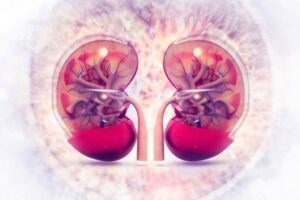Introduction
Chronic kidney transplant rejection (CKTR) is defined as a gradual loss of renal graft function that begins one year after transplantation and is frequently accompanied by hypertension and proteinuria. Patients with inadequate immunosuppression or drug nonadherence are more likely to develop CKTR.
Multiple risk factors, including as early ischemia reperfusion damage, acute rejectiton events, and transplant infectious illnesses, might contribute to the formation and progression of CKTR, whereas persistent allogeneic immune response remains a key cause.
Effective treatment and prognosis of CKTR are largely dependent upon the severity and reversibility of rejection at the time of diagnosis. But, early diagnosis of CKTR determines successful therapeutic interventions and prognosis. Despite the fact that histological evaluation through kidney biopsy remains the gold standard diagnostic criteria, it cannot be performed too frequently due to its invasiveness.
Perinephric hematoma, arteriovenous fistula, haemorrhage, and infection are all possible consequences of graft needle biopsy. There are also additional drawbacksto histologic inspection, such as a lack of standarization and quantification, sampling errors, and correct diagnosis relying heavily on pathologists’ abilities. As a result, non-/minimally invasive and predictive biomarkers for
early diagnosis and targeted innovations to delay or prevent CKTR and increase graft life are highly sought.
Biomarker discovery has greatly enhanced our understanding of CKTR. The discovery of molecular commonalities between CKTR, cancer immunology, and autoimmune disorders has led to groundbreaking research towards repurposing numerous cancer and autoimmune disease therapeutic methods to chronic active antibody-mediated rejection (ABMR) & Chronic active T cell mediated rejection (TCMR). IL-6/IL-6R blocker (Tocilizumab), C1 esterase inhibitor (C1 INH), and B-lymphocyte stimulator (BLyS) inhibitor (Belimumab) are only a few of the treatments that have been investigated for their therapeutic potential in preventing ABMR and have showed promising results.
Pathogenesis of Chronic Active ABMR and Chronic TCMR
Chronic active ABMR represents most cases of CKTR. featuring transplant glomerulopathy along with severe peritubular capillary basement membrane multilayering and new onset arterial intimal fibrosis. In contract, chronic active TCMR is determined based on inflammation in areas of the cortex with interstitial fibrosis and tubular atrophy (i-IFTA), a hallmark feature of CKTR in addition to tubulitis.
While precise mechanisms underlying ABMR remain elusive, it is believed that the interaction of donor-specific alloantibodies (DSAs) against donor HLA antigens, especially HLA class II antigens expressed by endothelial cells of the microvascular circulation, initiates ABMR. DSAs binding to endothelial cells leads to a cascade of molecular events, including complement activation that may contribute to endothelial dysfunction, microvascular inflammation and remodeling, and ultimately results in irreversible tissue injury.
TCMR is found to be strongly correlated with development of chronic active ABMR dnDSA. Moreover, it has been shown in biopsy-proven chronic active ABMR cases that T cells (especially CD8+T cells) and macrophages are the dominant infiltrating cell types in glomerulus, whereas B cells are frequently observed in the tubulointerstitial compartment, indicating that both T cells and macrophages play a pivotal role in renal chronic ABMR. Memory T cells are originated from environmental antigens or generated from previous rejection episodes and once activated, they enter into the renal interstitium and secrete several cytokines such as IFNγ and TGFβ, and subsequently trigger a cascade of inflammation
leading to tubulitis. Chronic TCMR also results in renal vasculature injuries, such as arterial inflammation and intimal fibrosis.
Potential Biomarkers for Early Diagnosis and Prognosis
Recent advancements in high-throughput cellular and molecular biotechnologies have resulted in significant biomarker discoveries in the field of transplantation, with considerable promise for better understanding and therapy of CKTR. Biomarker studies provide following benefits :
• Offering fresh insight into the molecular processes of CKTR
• Enabling for early and differential diagnosis
• Assessing treatment intervention
• Predicting prognosis
Transcriptomic Biomarkers
These biomarkers are generated by high-throughput gene or transcriptome profiling, also termed transcriptomics, using microarray and next generation gene sequencing technologies. These studies have been more commonly performed on renal biopsy samples as they provide suffcient material for RNA extraction. Gene signatures associated with fibrosis, i-IFTA, chronic rejection (ABMR and TCMR) and graft failure can be identified by determining gene expression profiling.
Importantly, the gene set has higher predictive capacity than that of baseline clinical variables, and clinical and pathological variables. One notion from these studies is that similar gene signatures for acute rejection are also indicative of CKTR.
Epigenetic Biomarkers
Epigenetic modifications and regulators control relevant gene expression and function in response to altered biological process, and thereby can be employed as disease biomarkers. Among the epigenetic changes include cytosine methylation of DNA at cytosine-phosphate diester-guanine dinucleotides, microRNA interactions, histone modifications, and chromatin remodelling complexes, all of which occur without changing the DNA sequence.
The majority of research have been conducted in the setting of ischemia and reperfusion damage, as well as acute rejection, to demonstrate the importance of abnormal DNA methylation. Recent research in both humans and animals has found that altered epigenetic modifications, particularly DNA methylation, affects the activation, proliferation, differentiation, and migration of a variety of cell types, including helper T cells or regulatory T cells and broblast, which are implicated in allograft survival and kidney fibrosis.
Proteomic Biomarkers
Scores of non-invasive proteomic biomarkers of CKTR are generated using high-throughput proteomic techniques, such as liquid chromatography-mass spectrometry (LC-MS), isobaric tag for relative and absolute quantitation (iTftQ), protein microarray, and bead-based immunoassay. Studies investigating non-invasive proteomic biomarkers in urine and blood, have discovered unique protein sets valuable for differential diagnosis. For example, one study on a set of 245 urine samples from a pediatric and young adult kidney allograft recipient cohort, identified 35 proteins that could discriminate three types of graft injury.
11 peptides for acute rejection, 12 urinary peptides for chronic allograft nephropathy and 12 peptides for BK virus nephritis were studied. Furthermore, several proteins, some chemokines and cytokines in blood and urine are also identified as biomarkers for diagnosing CKTR and predicting graft outcomes. Several recent efforts have established urinary C-X-C motif chemokine 9 (CXCL9) and CXCL10 as reliable biomarkers for subclinical allograft rejection and for guiding the post-transplant management.
Metabolomic Biomarkers
Metabolomics is a rapidly emerging research field that involves comprehensive analysis of all metabolites in a single biological sample and has recently gained tremendous interest in the biomarker study in organ transplantation. Compared to proteomic or transcriptomic markers, metabolomic biomarkers may be more precise in reflecting cellular functions. Metabolomics can be used in two ways: intensively analyzing and identifying individual metabolites; or using pattern recognition to record spectral patterns and intensities instead of recording individual molecules . Researchers recommend that metabolomic markers improve observing rejection and other organ injuries . In children, urinary metabolomics improved detection of borderline TCMR and demonstrated promise in ABMR.
Cellular Biomarkers
There has been significant attentions drawn to quantify alloreactive CD8+ T cells as potential cellular biomarkers of rejection, or tolerance. Ashokkumar et al. found that allospecific CD154+ T cytotoxic memory cells were associated with rejection risk in liver transplant recipients. Limited data showed that an increase in CD154+ subset is implicated in acute kidney transplant rejection. Resent studies showed that monitoring alloreactive memory IFN-γ-producing T cells could assess subclinical TCMR and predict de novo DSA, while ratio of T follicular helper cells and T follicular regulatory cells (Tfc/Tfr) was an independent risk factor for CAD. Both macrophages and NK cells are implicated in chronic rejection. However, it remains to be determined whether a specific subset of macrophages or NK cells could be served as cellular markers for CKTR.
New Therapies for the Treatment of CKTR
Numerous therapies have been used in the clinical setting, mostly focusing on chronic active ABMR have been evaluated in recent controlled trials and results have been extensively reviewed.
IL-6/IL-6R Blockade
IL-6 is a pleotropic cytokine associated to many facets of innate and adaptive immunity, which plays an important role in DSA generation and chronic ABMR, including its effects on B cell immunity and antibody-producing plasma cells, as well as the balance between effector and regulatory T cells. Blockade of the IL-6/IL-6R axis with Tocilizumab, anti–interleukin-6 receptor monoclonal antibody has been well-established for the treatment of rheumatoid arthritis, and is recently considered as a new therapy to prevent ABMR progression.
It has been shown that tocilizumab markedly reduced DSAs and stabilized renal function at 2 years post-transplant, suggesting a therapeutic effect of tocilizumab in ABMR. Another new inhibitor for IL-6/IL-6R axis is clazakizumab, a genetically engineered humanized monoclonal antibody directed against IL-6.
C1 Esterase Inhibitor (C1 INH)
Since the effcacy of C5 blockade in late ABMR is limited, blockade of early complement pathway at the level of key component C1 has attracted a great deal of attention. One potential strategy being studied is the use of C1 INH, which has been used to prevent and/or treat affacks of hereditary angioedema for years and has an established safety record.
C1-INH is a serum protease inhibitor that binds covalently and inactivates C1r, C1s, and mannan-binding protein-associated proteases. In a double-blind RCT, C1-INH was tested as a treatment for biopsy-proven ABMR. Both C1-INH and placebo groups showed improvements in early follow-up biopsies.
Inhibition of B-lymphocyte Stimulator
Belimumab, a humanized anti-BLyS antibody, which has shown therapeutic effcacy in systemic lupus erythematosus , has now been applied in organ transplantation. In a double-blind, randomized, placebo-controlled phase 2 trial, belimumab was evaluated in 28 kidney transplant recipients. The findings revealed that treatment of belimumab showed no effect on reducing the number of naïve B cells from baseline to 24 weeks after transplant. However, the activated memory B cells and plasmablasts were significantly reduced, and tissue-specific antibodies in serum were lowered.
Conclusion
The discovery of new early diagnostic biomarkers will not only allow for the development of tailored therapy for prompt therapeutic intervention, but will also enhance our understanding of CKTR pathophysiology. Despite the fact that many of the biomarkers still need to be validated and standardised in several independent cohorts, a number of potential treatments have been tested in large-scale intervention trials with encouraging outcomes.
References
1. Kasiske BL, Andany MA, Danielson B. A firty Percent Chronic Decline in Inverse Serum Creatinine Is an Excellent Predictor of Late Renal Allograft Failure. Am J Kidney Dis (2002) 39:762–8. doi: 10.1053/ajkd.2002.31996
2. Hara S. Current Pathological Perspectives on Chronic Rejection in Renal Allografts. Clin Exp Nephrol (2017) 21:943–51. doi: 10.1007/s10157-016-1361-x
3. Stegall MD, Park WD, Larson TS, Gloor JM, Cornell LD, Sethi S, et al. The Histology of Solitary Renal Allografts At 1 and 5 Years After Transplantation. Am J Transplant (2011) 11:698–707. doi: 10.1111/j.1600-6143.2010.03312.x
4. Shiu KY, Stringer D, McLaughlin L, Shaw O, Brookes P, Burton H, et al. Effect of Optimized Immunosuppression (Including Rituximab) on Anti-Donor Alloresponses in Patients With Chronically Rejecting Renal Allografts. Front Immunol (2020) 11:79. doi: 10.3389/fimmu.2020.00079
5. Loupy A, Haas M, Roufosse C, Naesens M, Adam B, Afrouzian M, et al. The Banf 2019 Kidney Meeting Report (I): Updates on and Clarification of Criteria for T Cell- and Antibody-Mediated Rejection. Am J Transplant (2020) 20:2318–31. doi: 10.1111/ajt.15898
6. Haas M, Loupy A, Lefaucheur C, Roufosse C, Glotz D, Seron D, et al. The Banft 2017 Kidney Meeting Report: Revised Diagnostic Criteria for Chronic Active T Cell-Mediated Rejection, Antibody-Mediated Rejection, and Prospects for Integrative Endpoints for Next-Generation Clinical Trials. Am J Transplant (2018)
18:293–307. doi: 10.1111/ajt.14625
7. Tsuji T, Iwasaki S, Makita K, Imamoto T, Ishidate N, Mitsuke A, et al. Preceding T-Cell-Mediated Rejection Is Associated With the Development of Chronic Active Antibody-Mediated Rejection by De Novo Donor-Specific Antibody. Nephron (2020) 144:13–7. doi: 10.1159/000512659
8. Everly MJ, Everly JJ, Arend LJ, Brailey P, Susskind B, Govil A, et al. Reducing De Novo Donor-Specific Antibody Levels During Acute Rejection Diminishes Renal Allograft Loss. Am J Transplant (2009) 9:1063–71. doi: 10.1111/j.1600-6143.2009.02577.x
9. Halloran PF, Chang J, Famulski K, Hidalgo LG, Salazar ID, Merino LM, et al. Disappearance of T Cell-Mediated Rejection Despite Continued Antibody-Mediated Rejection in Late Kidney Transplant Recipients. J Am Soc Nephrol (2015) 26:1711–20. doi: 10.1681/ASN.2014060588
10. Nankivell BJ, Shingde M, Keung KL, Fung CL, Borrows RJ, O’Connell PJ, et al. The Causes, Significance and Consequences of Inflammatory Fibrosis in Kidney Transplantation: The Banft i-IFTA Lesion. Am J Transplant (2018) 18:364–76. doi: 10.1111/ajt.14609
11. Roos-van GM, Scholten EM, Lelieveld PM, Rowshani AT, Baelde HJ, Bajema IM, et al. Molecular Comparison of Calcineurin Inhibitor-Induced Fibrogenic Responses in Protocol Renal Transplant Biopsies. J Am Soc Nephrol (2006) 17:881–8. doi: 10.1681/ASN.2005080891
12. Lefaucheur C, Loupy A. Antibody-Mediated Rejection of Solid-Organ Allografts. N Engl J Med (2018) 379:2580–2. doi: 10.1056/NEJMc1813976
13. Thomas T, Valenzuela NM, Reed EF. The Perfect Storm: HLA Antibodies, Complement, FcgammaRs, and Endothelium in Transplant Rejection. Trends Mol Med (2015) 21:319–29. doi: 10.1016/j.molmed.2015.02.004
14. Reese SR, Wilson NA, Huang Y, Ptak L, Degner KR, Xiang D, et al. B Cell Deffciency Aftenuates Transplant Glomerulopathy in a Rat Model of Chronic Active Antibody-mediated Rejection. Transplantation (2020). doi: 10.1097/TP.0000000000003530
15. Zhang R. Donor-Specific Antibodies in Kidney Transplant Recipients. Clin J Am Soc Nephrol (2018) 13:182–92. doi: 10.2215/CJN.00700117
16. Dieplinger G, Everly MJ, Briley KP, Haisch CE, Bolin P, Maldonado AQ, et al. Onset and Progression of De Novo Donor-Specific Anti-Human Leukocyte Antigen Antibodies After BK Polyomavirus and Preemptive Immunosuppression Reduction. Transpl Infect Dis (2015) 17:848–58. doi: 10.1111/tid.12467
17. De Keyzer K, Van Laecke S, Peeters P, Vanholder R. Human Cytomegalovirus and Kidney Transplantation: A Clinician’s Update. Am J Kidney Dis (2011) 58:118–26. doi: 10.1053/j.ajkd.2011.04.010
18. Sablik T, Jordanova ES, Pocorni N, Clahsen-van GM, Betjes M. Immune Cell Inflltrate in Chronic-Active Antibody-Mediated Rejection. Front Immunol (2019) 10:3106. doi: 10.3389/fimmu.2019.03106
19. Venner JM, Hidalgo LG, Famulski KS, Chang J, Halloran PF. The Molecular Landscape of Antibody-Mediated Kidney Transplant Rejection: Evidence for NK Involvement Through CD16a Fc Receptors. Am J Transplant (2015) 15:1336–48. doi: 10.1111/ajt.13115
20. Parkes MD, Halloran PF, Hidalgo LG. Evidence for CD16a-Mediated Nk Cell Stimulation in Antibody-Mediated Kidney Transplant Rejection. Transplantatio (2017) 101:e102–11. doi: 10.1097/TP.0000000000001586
21. Hirohashi T, Chase CM, Della PP, Sebastian D, Alessandrini A, Madsen JC, et al. A Novel Pathway of Chronic Allograft Rejection Mediated by NK Cells and Alloantibody. Am J Transplant (2012) 12:313–21. doi: 10.1111/j.1600-6143.2011.03836.x
22. Ge S, Chu M, Choi J, Louie S, Vo A, Jordan SC, et al. Imlifidase Inhibits Hla Antibody-mediated Nk Cell Activation and Antibody-Dependent Cell-Mediated Cytotoxicity (Adcc) In Vitro. Transplantation (2020) 104:1574–9. doi: 10.1097/TP.0000000000003023
23. Yazdani S, Callemeyn J, Gazut S, Lerut E, de Loor H, Wevers M, et al. Natural Killer Cell Infiltration Is Discriminative for Antibody-Mediated Rejection and Predicts Outcome After Kidney Transplantation. Kidney Int (2019) 95:188–98. doi: 10.1016/j.kint.2018.08.027
24. Lefaucheur C, Gosset C, Rabant M, Vigliethi D, Verine J, Aubert O, et al. T Cell-Mediated Rejection Is a Major Determinant of Inflammation in Scarred Areas in Kidney Allografts. Am J Transplant (2018) 18:377–90. doi: 10.1111/ajt.14565
25. Curci C, Sallustio F, Serino G, De Palma G, Trpevski M, Fiorentino M, et al. Potential Role of Effector Memory T Cells in Chronic T Cell-Mediated Kidney Graft
Rejection. Nephrol Dial Transplant (2016) 31:2131–42. doi: 10.1093/ndt/gfw245
26. Benichou G, Gonzalez B, Marino J, Ayasouft K, Valujskikh A. Role of Memory T Cells in Allograft Rejection and Tolerance. Front Immunol (2017) 8:170. doi: 10.3389/fimmu.2017.00170
27. Halloran PF. T Cell-Mediated Rejection of Kidney Transplants: A Personal Viewpoint. Am J Transplant (2010) 10:1126–34. doi: 10.1111/j.1600-6143.2010.03053.x
28. Stegall MD, Gaston RS, Cosio FG, Matas A. Through a Glass Darkly: Seeking Clarity in Preventing Late Kidney Transplant Failure. J Am Soc Nephrol (2015) 26:20–9. doi: 10.1681/ASN.2014040378
29. Kasiske BL, Zeier MG, Chapman JR, Craig JC, Ekberg H, Garvey CA, et al. KDIGO Clinical Practice Guideline for the Care of Kidney Transplant Recipients: A Summary. Kidney Int (2010) 77:299–311. doi: 10.1038/ki.2009.377





